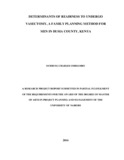Determinants of readiness to undergo vasectomy, a family planning method for men in Busia county, Kenya
Abstract
Kenya is among the sub-Saharan African countries with very high Total Fertility Rates
(TFR), currently at 4.6 per woman. The Total Population is 38.6 million with an annual
population growth rate of 2.8%. The population is projected to hit the 85 million mark by
the year 2050. The surest way to save ourselves is to maintain human Population at”
Carrying Capacity” and living in harmony with our environment through effective
voluntary family planning Programmes. This study investigated the factors that determine
the readiness to undergo vasectomy as a method of family planning among men whose
families are complete in Matayos location, Busia County. The study explored the
socioeconomic factors, vasectomy administration process and resource based factors that
determine men’s readiness to undertake vasectomy, a male family planning method. The
population in this study is 1024 male heads of households in Matayos Location, Busia
County. With a margin error of 5%, confidence level of 95% and a response distribution
of 50% the study anticipated to interview a sample of 279 Busia residents. A survey
questionnaire was used to collect data from the field using a descriptive cross sectional
survey. The questionnaire was pretested by conducting a pilot test on a sample of 10
respondents from Nambale location which has a similar geographical location as Matayos
location. The research instruments yielded a reliability coefficient of 0.81. Data analysis
was done by category into the demographics and the other independent variables.
Analysis was carried out in the SPSS version 19 based on descriptive and inferential
statistics using chi square and presented in the form of frequency tables. The study found
that the socio economic factors that affected men’s readiness to undergo vasectomy were
the number of years in marriage, number of children, and difference between the number
of boys and girls in the family, age of the youngest child, planning of the births and
whether the last child was planned or not. In the vasectomy administration factors, the
study established that use of needles affected men’s readiness to take up vasectomy,
recovery period from the surgical process and the type of family planning use by spouse.
In the resources that affected adoption of vasectomy, the study found that availability of
qualified vasectomists in the local health facilities and provision of wage compensation
during the process of recovery increased the chances of adoption of vasectomy. The study
recommends that there needs to be an improved campaign to remove stigma towards
vasectomy. This should be done by proper campaign in social centers such as schools,
churches and market places. This could also be done by involving local NGOs and
community leadership. The study also recommends that the government needs to be at
the forefront of the campaign to involve people in taking up vasectomy. The government
could also provide logistic support to the process. The study suggests that in future a
similar research needs to be done and involve the views of the vasectomists to make it
more inclusive. Secondly, the study suggests that in future a follow up study needs to be
done to assess whether adoption of the process has improved or not. Lastly the study also
suggests that a similar study needs to be done in other areas more so in areas of urban
setting so as to compare with the findings of this study
Citation
Master Of Arts In Project Planning And Management University of Nairobi,2014Publisher
University of Nairobi
Collections
- Faculty of Education (FEd) [5981]

